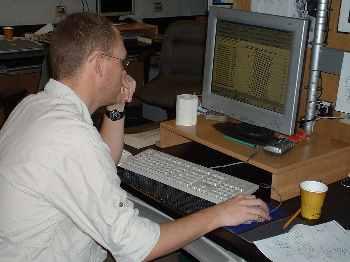4 February, 2004
The sun is circling lower on the horizon each day. After midnight
the sun taunts us with a dusky display of deep blue and purple, the
prelude to the reds and oranges of a glorious sunset, but the sunset
never comes. We are destined to have twenty-four hours of light
until the cruise ends. The first sunset in this part of Antarctica
will not be until March. Our internal clocks strain to make sense of
this night less situation. We great each other throughout the day
with a good morning or a goodnight, with little regard for the clock
that keeps ship's time. All that matters is if we are getting up or
going to bed. Meals have become times to make human connections and
gain nourishment. One day soon the sun will serve as conductor to
direct a symphony of sleep and wake in harmony with light and dark on
this cold continent.
Today was spent filling in the holes in the multibeam data. The ice
is constantly changing and the seafloor maps that we have made using
the multibeam sidescan sonar since the start of the cruise have
missing data because of this. The data "holes" are created when the
ship had to navigate around icebergs or large ice flows. The missing
data appears as white patches in the otherwise colorful contour maps
that are produced from the sonar data.
It took a cooperative effort between the ship's pilots and the
scientists to determine the day's impromptu away points that would
complete the coverage of all of the sonar map data. Using these maps
the geophysists will determine the best lines to transit to use the
seismic equipment to delve deeper than the contour maps take us, into
the upper layers of the Earth's crust.
The ship's course is constantly monitored using GPS (Global
Positioning Satellites). Every sidescan sonar pulse, and every
seismic air gun shot is recorded and stored aboard the ship's data
acquisition system with a precise location stamp given by the GPS.
Using the GPS we can return to within less than a meter of a location
that had been mapped earlier. We know exactly when the data was
collected as well using precision clocks that record the GMT,
Greenwich Mean Time. The combination of time and position stamps on
each data set measured and collected by the experimental equipment
makes the data that is recorded during the cruise very reliable and
precise.
The preliminary data from the sidescan sonar is manually edited file
by file in a process called ping editing. The sonar works by
producing a sound pulse, a ping that is directed downward from the
bottom of the ship to the seafloor. The sound is reflected back up
to the moving ship. One hundred and ninety one (191) receivers on
the bottom of the ship detect the echoed sound. The scientists call
the information that the receivers record a beam. One ping produces
191 beams. Each beam records information about distance to the
seafloor that is then used to create seafloor contour maps.
Ideally, each ping would produce a perfect data set of beams, but
this does not occur for a variety of reasons. The most common causes
of errant beams is rolling and pitching of the ship in rough seas,
noise caused by moving through the ice, and changing of the position
of the ship during turns.
Before the ping data can be used for mapping, we edit each file.
About twenty-four files are produced each day. We look for the errant
beams and delete them from the data that will be used in the final
mapping. The original data set still has the "bad" beams and will be
saved for future reference by the scientists. The ping editing
process is slow and methodical. We follow general guidelines, but it
is primarily through experience that you become efficient and
accurate at ping editing.
After each file is edited, a map of that data is printed and compared
to the raw data. Chris Linden, multibeam support, and Marcy Davis,
from UTIG catch any glairing errors made during editing in "quality
control". Each of these individual files is then combined to form
large finished maps of the data.
The ice has been cooperative. We should have all of the holes filled
in the multibeam data by tomorrow. Traffic in McMurdo Sound is
picking up. Container ships with supplies for the winter and next
year are making their way into McMurdo port. The end of the summer
in Antarctica means the end of the science field season. Our science
crew is scheduled to be on the second to last flight out of McMurdo.
The population at McMurdo will be reduced to the winter overs.
Everyone that has not left on the last flight is in Antarctica for
the winter. It will be October before the next flight returns.

A preliminary multibeam map showing holes from empty data, and the current ship track.

Jerome Hall from Ohio State works on a mutibeam ping file.

Contact the TEA in the field at
.
If you cannot connect through your browser, copy the
TEA's e-mail address in the "To:" line of
your favorite e-mail package.
|
